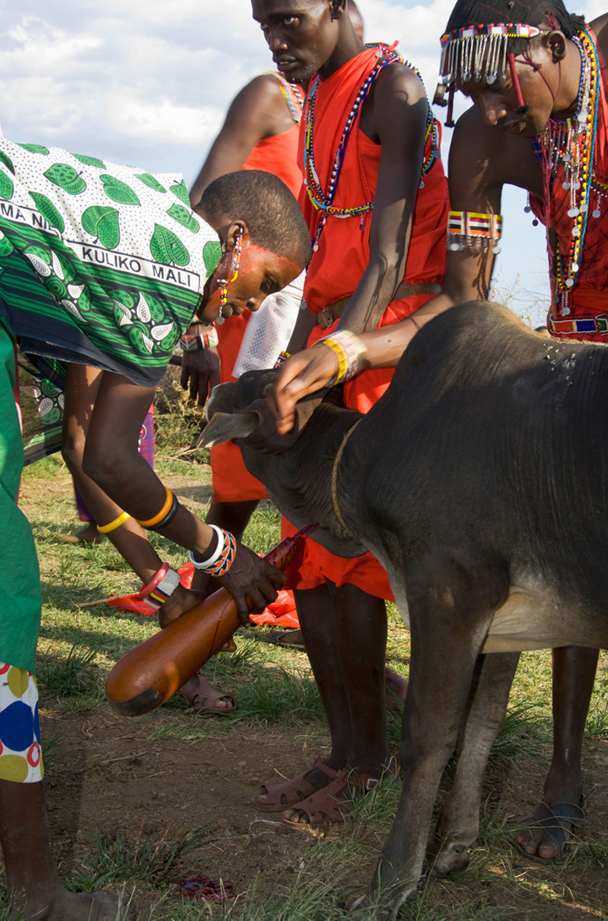Mshipa ambaye imekatwa. Jeraha imezibwa na mavi ya ng’ombe. Damu nyepesi.
These Swahili phrases roll off Lbukshash Lepeta’s tongue, sounding almost poetic—until I hear the rather unappetizing translation into English of the ingredients of one of his tribe’s traditional drinks: a blend of fresh animal’s blood and milk.
The mix is an everyday source of nutrition for Kenya’s Samburu and Masai people, who rely on animal blood for protein and vitamins. They are even able to survive on the blood-milk mixture and water alone during the dry season when other sources of nutrition are scarce. But the drink is more than simple sustenance, as each of six varying preparations has symbolic meanings tied to specific life stages and tribal ceremonies.
Collecting the blood from cows, sheep, goats, and camels involves a delicate bleeding process in which the animal is either bled routinely on a two-week basis and kept alive, or bled once and then slaughtered. The routine bleedings produce anywhere from three to four pints of fresh blood, which is enough for a meal for five grown men. A special type of arrow, and incredibly careful aim, are used to ensure the animal stays alive week after week.
“The arrow is called a blocked arrow because it’s only designed to penetrate through the skin and halfway through the artery in the neck,” says Stanley Ambrose, a professor of anthropology and African studies at the University of Illinois. “It’s a very short arrow that goes into the jugular, then the blood spills out into a gourd.” (The “blocked” arrow’s stopping device makes it a better tool for the job than a knife.) “Because it’s shot at such close range, there’s no chance of missing,” says William Carr-Hartley, founding partner of Nairobi-based Carr-Hartley Safaris and a native Kenyan. “They also tie a tourniquet around the neck to get the vain to bulge, so it’s a bit bigger and [the shooter] can see it better.” Mud and cow dung are combined into a paste that’s then pressed into the artery to stop the blood gushing from the cut.
After the fresh blood has been collected, it’s thinned using a long stick with three prongs. The tool, which resembles a whisk, is feverishly twirled around in the hot blood for several minutes until the coagulant in the blood sticks to it. The coagulant is either discarded or cooked and eaten, and the thinned blood is then mixed with cow’s or goat’s milk in various ratios depending on who will consume it and for what purpose. The milk may come directly from the animal being bled (if it is a female, of course), or it is collected from another animal nearby.
Young boys and girls alike enjoy ncharligi, which is made by mixing 2 parts warmed milk with 1 part de-coagulated blood. “Adding hot milk to the blood turns it a very dark color,” says Lepeta, who was the game spotter during my trip to Africa, covered in the recent feature “A Culinary Safari in Kenya.” “So it doesn’t look like a [bright-red] blood mixture anymore, and the children prefer that because they don’t like to see blood.”
Samburu boys get a stronger taste of the blood-milk drink, known affectionately by non-Samburu Kenyans as the Samburu Cocktail, directly following their circumcision ceremony between the ages of 13 and 17. The saroi preparation is a mixture of 11/2 parts de-coagulated blood to 1 part fermented milk, with the greater ratio of blood believed to supply growing boys with ample nutrients like iron. “It’s very salty and has more of a bloody rather than milky taste,” Lepeta says, speaking through his translator, Carr-Hartley.
All age groups dine daily on lukuworie, a blend of hot cow’s milk and hot cow’s blood that has not been de-coagulated. The temperatures of the two liquids are critical; if you wait until the blood has cooled it will have already coagulated and become too thick to drink. During food shortages this thicker consistency is preferred and relied upon, as the Samburu prepare a black pudding-like dish known as nchorde by cooking fresh blood until it becomes hard and lumpy, according to Carr-Hartley. They eat the thickened blood (without the addition of dairy) and can survive solely on nchorde and water for days at a time.
As boys mature into men, or what the Samburu call “warriors,” they continue drinking saroi in addition to nchopet, or hot blood consumed directly from an animal slaughtered as part of a sacrifice during a religious ceremony, such as a wedding or birth celebration. A knife, rather than a bow and arrow, is used to bleed the animal via a single incision made through its primary neck bone, which causes the animal to die instantly. The jugular is then pierced, causing a rush of blood to pour from the animal’s neck. The warriors drink directly from the freshly flowing vein and do not mix the hot blood with any type of dairy.
The final preparation, munono, can only be consumed by Samburu elders and is more of a dish than a drink. “The meat from a slaughtered animal is cooked in a pot over an open flame and mixed with a small amount of water until the fat rises to the top,” Lepeta explains. The Samburu then add de-coagulated blood to the pot and cook it until it becomes a thick blood stew, rich in calories and fat.
From birth until death, the Samburu, along with the nearby Masai people, rely on the blood-milk combination as a vital source of nutrition. And as far as the flavor? I declined to drink this particular cocktail, but Carr-Hartley described it as “hot, salty, and coppery.” And to my question, Lepeta cracked a smile and simply replied, “It’s awesome-tasting.”



 Pinterest
Pinterest


